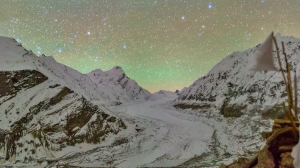 Tso Kar (Ladakh) : Tso Kar (Ladakh) : Tso Kar (Ladakh) | August 25, 2025
Ladakh, one of India’s most pristine yet fragile regions, is standing on the frontline of climate change. Once known as the “frozen desert,” it is now witnessing alarming glacier retreat, mounting water stress, and increasing natural disasters. The consequences are no longer distant — they are reshaping the daily lives of over three lakh residents.
A Region in Flux
In mid-August, twin cloudbursts struck Ladakh while flash floods disrupted the Jammu-Leh highway. Around the same time, a massive cloudburst in Jammu & Kashmir’s Kishtwar district killed at least 40 people and left over 100 missing. Such events underline how climate volatility is turning Himalayan states into disaster hotspots.
Rampant urbanisation, unchecked tourism, and increased troop mobilisation have accelerated the strain on Ladakh’s already limited resources. Vehicular emissions, carbon soot on glaciers, and growing water demands are compounding the crisis, further destabilising fragile ecosystems.
Melting Giants
At the heart of Ladakh’s crisis lies its vanishing glaciers. The Drang-Drung glacier near Pensi La, the second largest in Ladakh after Siachen, has shrunk significantly. Glacial meltwater once sustained irrigation, agriculture, domestic use, and the Indus and Zanskar rivers. But scientists now note an earlier and faster melting season, leading to reduced groundwater recharge and shifting hydrological cycles.
Since the Little Ice Age around 1650 AD, Ladakh’s glacier area has shrunk by nearly 40 per cent and volume by 25 per cent. Experts warn that the pace of change is accelerating. “The seasonality of meltwater is destabilising long-standing cycles, and retreating glaciers are leaving behind depressions that can turn into hazardous glacial lakes,” explained Dr. Farooq Azam, Associate Professor at IIT Indore.
Migration on the Rise
Glacier loss is now triggering a quieter crisis: internal migration. For centuries, villages in Ladakh relied on nearby glaciers for their water needs. But with many disappearing, families are abandoning ancestral homes. Padma Rigzin, a Ladakhi PhD scholar, noted: “We are already seeing elders move to neighbouring villages with functioning streams. This silent migration is placing extra pressure on receiving communities.”
The added demand risks accelerating glacier decline, creating a vicious cycle that threatens both livelihoods and cultural continuity.
Disasters Waiting to Happen
As glaciers retreat, they expose vast basins that often fill with meltwater, forming glacial lakes. These lakes are unstable and prone to outburst floods. The 2023 Sikkim disaster, which killed scores, highlighted the catastrophic potential of such events.
ISRO’s National Remote Sensing Centre has already flagged Jammu & Kashmir and Ladakh as high-risk zones. Across the Himalayas, 4,400 glacial lakes have been mapped, with several in Ladakh posing severe flood risks due to steep terrain and fragile climatic conditions.
Water Under Pressure
Tourism, which boomed after the Covid-19 lockdowns, has sharply increased water consumption. Hotels and homestays in Leh are tapping groundwater at unsustainable rates, while tourists unfamiliar with Ladakh’s frugal water culture exacerbate shortages. Meanwhile, heightened troop deployment along the Line of Actual Control with China since the 2020 Galwan clash has added to the stress.
The Road Ahead
Ladakh today stands at the intersection of climate crisis, migration, and natural hazards. Without urgent intervention, sustainable water practices, and proactive disaster preparedness, the region faces a precarious future.
For a land once defined by its timeless glaciers and icy rivers, the prospect of vanishing ice may well determine the destiny of Ladakh. |